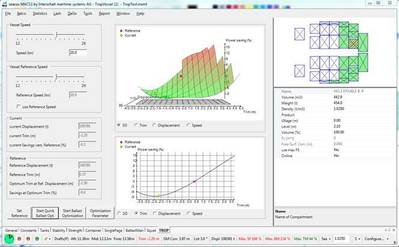Improved Fuel Economy with Trim Optimization
INTERSCHALT maritime systems AG presents its new fuel saving TROP trim optimization software.
The maritime-shipping industry has also been forced to contend with the key issues of energy efficiency and sustainability. Optimizing the trim of a ship is a good way to achieve lasting reductions in fuel consumption. In fact, trim optimization has been an object of investigation since the 1990s. Back then, forward-thinking German shipowners were using models in towing tests designed to determine the trim that produced the lowest resistance as a ship moved through water. These tests showed that in many cases a slightly lower forward draft yielded the ideal trim. Based on these findings, INTERSCHALT added a ballast optimization tool to its MACS3 loading computer system. However, over the next 15 years interest in this special module declined because the costs for conducting the associated towing tests proved to be too high.
"These days, towing tests can be realistically and economically simulated with special software," states Bernhard Finke, a software developer at INTERSCHALT. "However, determining the optimum trim is one thing; being able to practically apply these findings in actual ship operation is another." After a ship has been loaded, the crew usually has only one method left to alter its trim: by using the ballast tanks. But here the following questions arise: How do the tanks need to be filled to achieve the ideal trim? How will this affect stability and strength? The new TROP trim optimization module, now fully integrated into INTERSCHALT's proven MACS3 loading computer system, answers these critical questions. As Bernhard Finke notes: "The user can now even automatically determine the best ballast distribution necessary to save the greatest amount of fuel." In making its calculations, TROP also takes into account all safety regulations pertaining to stability and strength.
So how much fuel can be saved? The answer to this question does depend on many factors, such as the size of the ship, its speed, the weather, how calm or rough the sea is, and so on. Here's an example for a medium-sized container ship with approximately 7,500 TEU of capacity: At a speed of 20 knots, it's realistic to expect savings of 2 to 3%. At a bunker price of around $600 per ton of fuel, this yields savings of from $1,500 to $2,200 per day.














